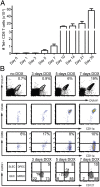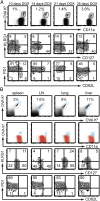Distinct mechanisms mediate naive and memory CD8 T-cell tolerance
- PMID: 23236165
- PMCID: PMC3535649
- DOI: 10.1073/pnas.1217409110
Distinct mechanisms mediate naive and memory CD8 T-cell tolerance
Abstract
Peripheral tolerance to developmentally regulated antigens is necessary to sustain tissue homeostasis. We have now devised an inducible and reversible system that allows interrogation of T-cell tolerance induction in endogenous naïve and memory CD8 T cells. Our data show that peripheral CD8 T-cell tolerance can be preserved through two distinct mechanisms, antigen addiction leading to anergy for naïve T cells and ignorance for memory T cells. Induction of antigen in dendritic cells resulted in substantial expansion and maintenance of endogenous antigen-specific CD8 T cells. The self-reactive cells initially exhibited effector activity but eventually became unresponsive. Upon antigen removal, the antigen-specific population waned, resulting in development of a self-specific memory subset that recalled to subsequent challenge. In striking contrast to naïve CD8 T cells, preexisting antigen-specific memory CD8 T cells failed to expand after antigen induction and essentially ignored the antigen despite widespread expression by dendritic cells. The inclusion of inflammatory signals partially overcame memory CD8 T-cell ignorance of self-antigen. Thus, peripheral CD8 T-cell tolerance for naïve CD8 T cells depended on the continuous presence of antigen, whereas memory CD8 T cells were prohibited from autoreactivity in the absence of inflammation.
Conflict of interest statement
The authors declare no conflict of interest.
Figures





References
-
- Gallegos AM, Bevan MJ. Central tolerance: Good but imperfect. Immunol Rev. 2006;209:290–296. - PubMed
-
- Liston A, Rudensky AY. Thymic development and peripheral homeostasis of regulatory T cells. Curr Opin Immunol. 2007;19(2):176–185. - PubMed
-
- Pape KA, Merica R, Mondino A, Khoruts A, Jenkins MK. Direct evidence that functionally impaired CD4+ T cells persist in vivo following induction of peripheral tolerance. J Immunol. 1998;160(10):4719–4729. - PubMed
Publication types
MeSH terms
Substances
Grants and funding
LinkOut - more resources
Full Text Sources
Other Literature Sources
Molecular Biology Databases
Research Materials

